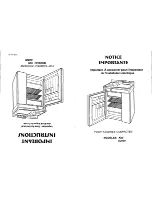
7
IIn
nsstta
alllla
attiio
on
n m
mu
usstt m
me
ee
ett llo
occa
all p
pllu
um
mb
biin
ng
g cco
od
de
e
rre
eq
qu
uiirre
em
me
en
nttss
Use only 1/4” (6 mm) copper tubing for water
line. Do Not install copper tubing in area
where temperatures drop below
35˚ F (1.7˚ C).
• Viking Range, LLC is not responsible for
property damage due to improper
installation or water connection.
• Length of copper tubing must reach from
water supply connection to the unit
connection with an additional length to
facilitate moving the unit out of enclosure for
cleaning or service. Tubing should be soft
instead of rigid and ends should be free of
burrs.
• If additional tubing is needed, use copper
tubing and check for leaks. Install the copper
tubing only in areas where the household
temperatures will remain above freezing.
• Do not use plastic water lines from the
household plumbing to the water inlet
valve connection on the refrigeration unit.
• Do not use the self-piercing feature of a
saddle valve. The hole made by the piercing
lance is too small for the water flow rate
required by the ice maker.
W
Wa
atte
err P
Prre
essssu
urre
e
A cold water supply with water pressure
between 30 and 120 psi (207 and 827 kPa) is
required to operate the water dispenser and
ice maker. If you have questions about your
water pressure, call a licensed, qualified
plumber.
R
Re
evve
errsse
e O
Ossm
mo
ossiiss W
Wa
atte
err S
Su
up
pp
pllyy
IMPORTANT: The pressure of the water
supply coming out of a reverse osmosis
system going to the water inlet valve of the
refrigerator needs to be between 30 and
120 psi (207 and 827 kPa).
If a reverse osmosis water filtration system is
connected to your cold water supply, the
water pressure to the reverse osmosis
system needs to be a minimum of 40 to 60
psi (276 to 414 kPa). If the water pressure to
the reverse osmosis system is less than
40 to 60 psi (276 to 414 kPa):
• Check to see whether the sediment filter in
the reverse osmosis system is blocked.
Replace the filter if necessary.
• Allow the storage tank on the reverse
osmosis system to refill after heavy usage.
• If your refrigerator has a water filter
cartridge, it may further reduce the water
pressure when used in conjunction with a
reverse osmosis system. Remove the water
filter cartridge. If you have questions about
your water pressure, call a licensed,
qualified plumber.
6
Water Supply Requirements
W A R N I N G
To avoid serious illness or death, do not use unit
where water is microbiologically unsafe or of
unknown quality without adequate disinfection
before or after the system. Systems certified for
cyst reduction may be used on disinfected water
that may contain filterable cysts. The contaminants
or other substances removed or reduced by this
water treatment system are not necessarily in you
water.
• The water shutoff should be located in the
base cabinet on either side of the
refrigerator or some other easily accessible
area. The right-hand side is recommended.
The access hole through the cabinet must
be within ¹⁄
2
" (12.7 mm) of the rear wall.
N
NO
OT
TE
E: If the water shutoff valve is in the
back wall behind the refrigerator, it must be
at an angle so that the tube is not kinked
when the refrigerator is pushed into its final
location.
• If the water shutoff valve is not in the
cabinets, the plumbing for the water line
can come through the floor. A ¹⁄
2
" (12.7
mm) hole for plumbing should be drilled at
least 6" (15.2 cm) fromthe right or left
hand side cabinet or panel. On the floor,
the hole should be no more than 1" (2.54
cm) away from the back wall. See
“Connect the Water Supply”.
24"
(60.96 cm) min.
1"
(2.54 cm)
6"
(15.2 cm)
6"
(15.2 cm)
6"
(15.2 cm)
Summary of Contents for Built-in French Door Bottom-Freezer Refrigerator
Page 12: ...23 22 ...






























